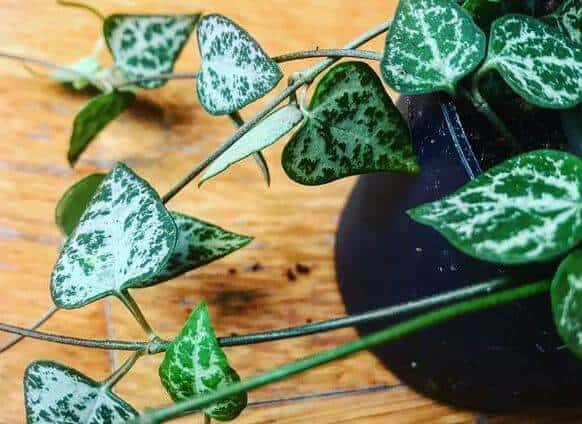Last Updated on January 6, 2023 by a Friendly Gardener
A dainty houseplant with heart-shaped leaves that resemble spades, the String of Spades (Ceropegia woodii) is also known by other names including sweetheart vine, rosary vine, hearts-on-a-string, chain of hearts, collar of hearts, and more.
An extremely fast-growing evergreen trailing vine, the String of Spades is perfect for growing in containers placed along windowsills or shelves or in hanging baskets.
Mostly grown as a houseplant, the String of Spades is also sometimes grown in rock gardens, as spreading ground cover or trailing down walls.
The attractive plant is a very easygoing plant that’s very easy to care for and is especially a great option for people who don’t have a lot of time to care for their plants or for beginner plant owners.
About the String of Spades Plant

Native to South Africa, Zimbabwe, and Eswatini, the String of Spades is a flowering evergreen succulent belonging to the Apocynaceae family.
The plant has small 1-2 cm long and wide, fleshy, heart-shaped, grayish-green leaves with an attractive marbled, variegated pattern.
The leaves grow on thin vines having a characteristic purple color, which grow to a height of around 10 cm and spread up to 2-4 m in length.
When it grows older, the plant grows a woody caudex at the base. The stems and the roots often develop tubers, which gives the plant one of its common names i.e., the rosary vine.
The String of Spades plant grows small inch-long tubular purple or pale magenta-colored blooms, having a bulbous base. The flowers usually bloom in the summer or late fall, but may also appear during other times of the year.
String of Spades Plant Care
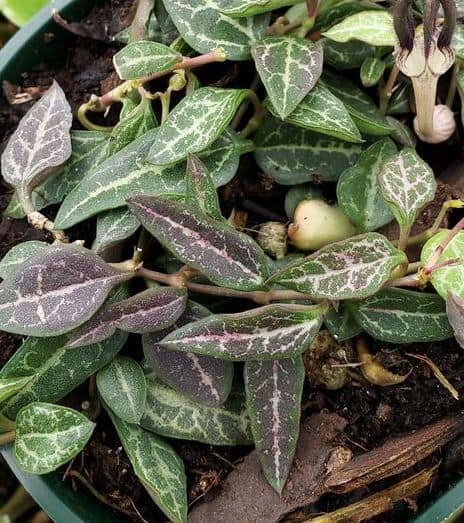
If you want to grow the String of Spades plant, it is quite easy to do it. These plants grow well in the USDA hardiness zones 10-12 but in colder climates, they can be grown as houseplants.
Below are the details of the conditions that are needed to grow the String of Spades plants.
Light
The String of Spades plant grows and blooms best in bright but filtered sunlight. When grown as a houseplant, place the plant near a bright window sill, where the vines can cascade downwards.
Temperature and Humidity
String of Spades plants grow well in warm climates and thrive in regular temperatures in the home. But they don’t do very well in intense heat.
For very short periods, these plants can tolerate temperatures down to 20°F but don’t do well when exposed to the cold for a long time, especially if they haven’t retained enough moisture.
The String of Spades plant does not need a lot of humidity and grows quite well in most homes. So, there is no need to mist the plants or use a humidifier.
If the leaves of the String of Spades plant turn soft and mushy, it means that the humidity is too high for the plants. Also, misting the plant can cause leaf rot and fungal infections.
Soil
The String of Spades plant grows well in well-draining soil. In their natural habitat, these plants grow in rocky and sandy conditions.
So, it is best to avoid using rich garden soil for the plant or topsoil that retains a lot of moisture as this can cause the plants to become straggly.
The plant prefers slightly acidic soil having a pH level between 5 and 7. When using a regular potting mix, add perlite or pumice to ensure proper drainage.
Watering
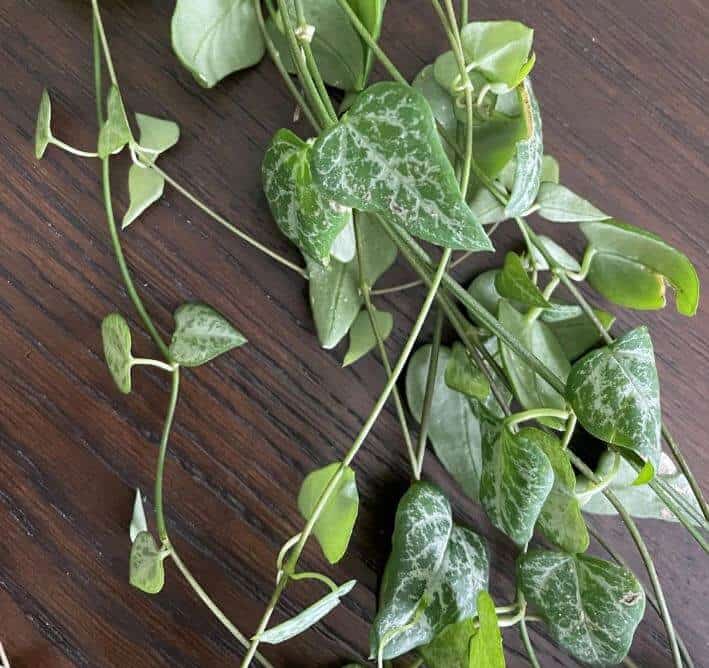
String of Spades plants are drought-tolerant succulents and so they don’t require a lot of water to survive. In the summer months, water the plant only when the soil has dried out fully between the waterings.
In the winter, water the plant sparingly. Overwatering can lead to the foliage becoming swollen and also cause leaf drops.
Pests and Diseases
The String of Spades plant is quite a hardy plant and is generally disease and pest-free. But it may be susceptible to attacks by snails and slugs that can destroy the plants.
The String of Spades plant may be susceptible to fungal diseases and leaf rot if the humidity is very high.
Fertilizing
Fertilize your String of Spades plant 1-3 times a year. Use a diluted water-soluble fertilizer. It is best to fertilize during the summer, spring and fall.
Repotting and Pruning
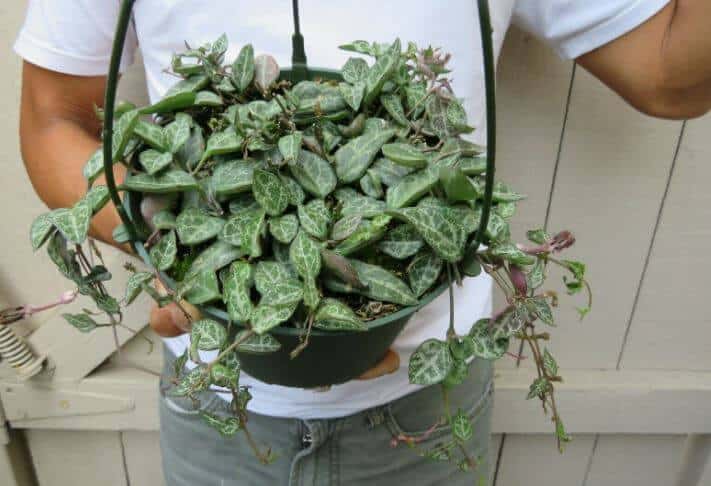
String of Spades plants are prolific growers when the conditions are right. And once every few years, it is best to repot them. But you must take care when repotting the plant as the vines are very delicate and can break easily.
Also, ensure that the new pot/container you are using to repot the plant has sufficiently big holes for good drainage. Keeping your String of Spades plant pruned helps in the healthy growth of the plant and also prevents it from looking unkempt.
It is best to prune your String of Spades plant in summer or early spring.
String of Spades Plant Propagation
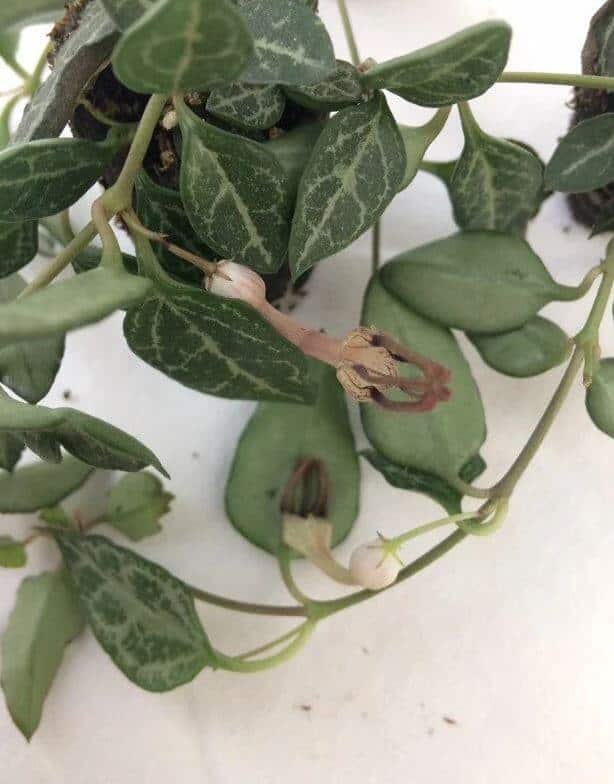
Typically, the String of Spades plant is propagated from stem cuttings rather than by seeds because getting seeds of the plant is quite difficult.
The method of stem-cutting propagation is quite easy. A stem cutting with 2 internodes at least develops roots within a period of 15 days to 2 months.
You can also use the single leaves or the tubers, which develop along with the stem for propagation. Make sure that the potting mix is moist at all times and that the container is placed in a warm area having bright but filtered light.
You can also sit the cuttings in water initially and once they develop roots, you can transplant them into the potting mix.
Wrapping Up
If you’re on the lookout for a very low-maintenance plant that can thrive even if neglected for a few days, then the String of Spades is a great choice.
These beautiful trailing succulents with their spade-shaped leaves, long cascading vines, and beautiful purple-colored flowers are truly unique and can be a wonderful addition to your home, balcony, or patio and are guaranteed to add a splash of color wherever you place them.

